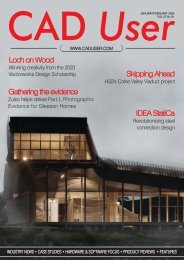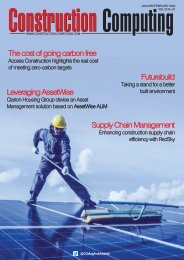Create successful ePaper yourself
Turn your PDF publications into a flip-book with our unique Google optimized e-Paper software.
TECHNOLOGYfocus<br />
Making the most of a CDE<br />
Nassim Saoud, Director EMEA at Trimble Consulting explains why common data environments<br />
help construction teams increase collaboration and reduce risk<br />
Major construction projects come<br />
with major data challenges. Large<br />
infrastructure projects are no<br />
exception - not only is there the sheer<br />
volume of data to gather, but there are also<br />
many different teams each using their own<br />
technology tools, most of which won't<br />
communicate seamlessly. As a result,<br />
manual data sharing is common, taking up<br />
valuable time and resources, and leading<br />
to errors and omissions that trigger design<br />
changes and rework.<br />
A common data environment (CDE),<br />
providing a unified view and single source<br />
of truth about each project, can help<br />
mitigate the challenges of growing<br />
sustainability pressures, tighter budget<br />
constraints, and labour shortages.<br />
Centralised and consolidated project<br />
information can be the catalyst that helps<br />
minimise rework and RFIs, use materials<br />
and equipment more efficiently and reduce<br />
overall project risk.<br />
Using a CDE also enables digital project<br />
delivery, which is used to produce models<br />
for visualisation, collect 3D survey<br />
data, create contract<br />
plansheets,<br />
record as-built data, and develop<br />
digital twins. Having a data-rich, accurate<br />
representation of a project enables project<br />
stakeholders to monitor construction<br />
progress and manage resources more<br />
effectively. Post-construction, digital twins<br />
provide owners with insight into the design<br />
and construction decisions behind the<br />
asset. Sensors continually record<br />
information on utilisation, weather and<br />
more, which is fed back into the digital<br />
twin. With this comprehensive data<br />
collected throughout the lifecycle of the<br />
asset, owners can simplify and optimise<br />
maintenance and operations.<br />
Ideally cloud-based platforms, the most<br />
advanced CDE's are accessible from a<br />
range of devices, including computers,<br />
mobile phones, tablets, and even<br />
machines in the field. Project stakeholders<br />
can access BIM models, GIS data,<br />
contract documents, estimates, work<br />
plans and reports from anywhere, as well<br />
as granular data like installation details and<br />
materials specifications.<br />
A CDE can also play a vital role in<br />
achieving better outcomes with BIM.<br />
Currently, most AEC firms use BIM<br />
primarily for design, leaving much of the<br />
potential value for improving project<br />
delivery unused, with teams still operating<br />
in silos. BIM can help stakeholders share<br />
information across construction<br />
disciplines. They can leverage the model<br />
to capture and retrieve data throughout all<br />
phases of the project, not just design. BIM<br />
becomes a shared source of truth for the<br />
various design professionals, engineers,<br />
contractors, specialists, and owner<br />
stakeholders involved in the project.<br />
With a CDE adding centralised access to<br />
accurate project data, multidisciplinary<br />
teams improve collaboration further, reduce<br />
waste and rework, and can share data with<br />
owners to inform ongoing management<br />
and maintenance projects. A CDE provides<br />
a shared, centralised, and federated view<br />
through a Master Assembly, bringing all<br />
disciplines together, and enabling custom<br />
and tailored data consummation for each<br />
project role, offering the ability to switch<br />
between macro views and very detailed<br />
micro views.<br />
FIVE WAYS TO MAXIMISE THE<br />
VALUE OF A CDE<br />
A CDE is a powerful platform, but it has to<br />
be set up and used consistently to truly<br />
20<br />
<strong>Jan</strong>uary/<strong>Feb</strong>ruary <strong>2022</strong>

















